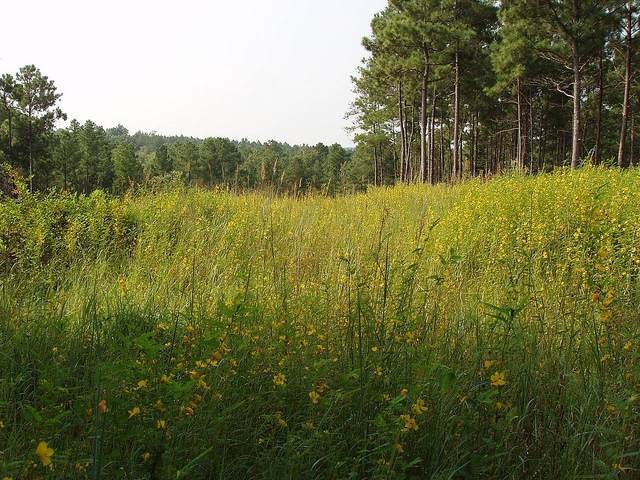
Last month, the U.S. Department of Agriculture (USDA) announced the results of the fiscal year (FY) 2017 competition for conservation project funding through the Regional Conservation Partnership Program (RCPP). As we reported in a previous post, USDA’s investment of $225 million was met with a non-federal investment of $500 million from a variety of local partners, including state agencies and non-governmental organizations. On Thursday, January 12, USDA published its call for RCPP proposals for FY 2018, pledging a public investment of $252 million.
RCPP is administered by the USDA’s Natural Resource Conservation Service (NRCS), which uses the program to partner with state agencies and non-governmental organizations in providing financial and technical assistance to farmers for conservation projects. RCPP projects generally fall into two categories: those that address targeted natural resource concerns in a given project area, and those designed to meet the specific conservation needs of a given set of farmers. One project funded in FY 2016, for example, preserves species diversity in the “Driftless Area” of Minnesota and Wisconsin, while a project like the innovative tribal conservation and greenhouse gas management project being led by Alaska’s Intertribal Agriculture Council is an example of a farmer group-focused project.
RCPP requires the submission of both a pre-proposal and a full proposal. Pre-proposal applications are due April 21, 2017 at 5 p.m. EST. Pre-proposal applicants can expect to hear back by June 26, 2017. For those applicants with approved pre-proposals, full applications will be due August 31, 2017 at 5 p.m. EST. USDA will announce award recipients in November. All RCPP proposal details can be found in the FY 2018 Announcement for Program Funding (APF).
In addition to the APF, NRCS includes a variety of useful information about RCPP (including a FAQ) on its website.
Eligibility and Enrollment
Unlike most USDA programs, farmers and ranchers do not apply directly for funding through RCPP. Instead, the partnering entities take the lead on developing and submitting project proposals. Eligible partners include (but are not limited to): public and private institutions of higher learning, producer associations, a state or local government agency, Indian tribes, and municipal water or waste treatment facilities. Together with NRCS, these partners are key co-investors in conservation and the environment. Once NRCS selects proposals, farmers and ranchers are able to apply through NRCS to participate in RCPP projects.
Program Details
Like last year, the FY 2018 APF allocates 35 percent of total RCPP funding for projects in Critical Conservation Areas (CCAs), 40 percent to NRCS national headquarters for other national priorities, and 25 percent to state NRCS offices for in-state projects. Money allocated to the states will be awarded to projects by the NRCS state office.
The eight CCAs as defined by NRCS include: Chesapeake Bay Watershed, Great Lakes Region, Mississippi River Basin, Colorado River Basin, Longleaf Pine Range, Columbia River Basin, California Bay Delta, and Prairie Grasslands. The Prairie Grasslands region includes North Dakota, Nebraska, and Kansas, nearly all of South Dakota and Iowa, and parts of Montana, Wyoming, Colorado, New Mexico, Texas, Oklahoma, Minnesota, and Missouri.
The ranking criteria for assessing project proposals has not changed relative to last year. NRCS will assign 25 percent of the ranking points based on how partners engage communities to identify resource management objectives and solutions that are enduring and locally supported.
Twenty-five percent of a proposal’s ranking score will be based on an assessment of the partner contribution. NRCS will assess both the amount of funding that a partner will bring to the table as well as the extent and type of in-kind activities, such as outreach and education, that partners will contribute.
Another 25 percent of the ranking points will be based on the extent to which a project proposal is “innovative”. Innovative projects include those which:
- Establish or demonstrate environmental markets or conservation investment strategies.
- Use new and innovative methods, technologies, and approaches that are documented as feasible, to deliver conservation and overcome previous limitations to conservation adoption.
- Support the improvement of existing or the creation of new conservation practice standards; and/or use suites of conservation activities.
USDA will assign the final 25 percent of the ranking points based on the level and extent of participation by farmers, private businesses, utilities, and other stakeholders.
Threats to RCPP
RCPP pulls a large portion of its funding from other USDA conservation programs, including the Environmental Quality Incentives Program (EQIP), Conservation Stewardship Program (CSP), and Agriculture Conservation Easement Program (ACEP). Through the Farm Bill, RCPP baseline funding is set at roughly $93 million each year ($100 million less $7 million in automatic annual cuts via sequestration). The remainder comes from the underlying programs listed above. As a result, RCPP funding is directly affected by any cuts made to those programs.
Last year, for example, congressional appropriators used a backdoor budget gimmick known Changes in Mandatory Program Spending (CHIMPS) to severely cut EQIP funding, which resulted in a $37.5 million cut to RCPP in the final FY 2016 appropriations package.
For FY 2018, USDA is operating under the assumption that Congress will once again use CHIMPS to cut conservation funding during the appropriations process. The FY 2018 appropriations cycle will begin sometime this spring, and NSAC will vigorously fight any conservation CHIMPS that are proposed during the process.
You can follow the appropriations process here.

